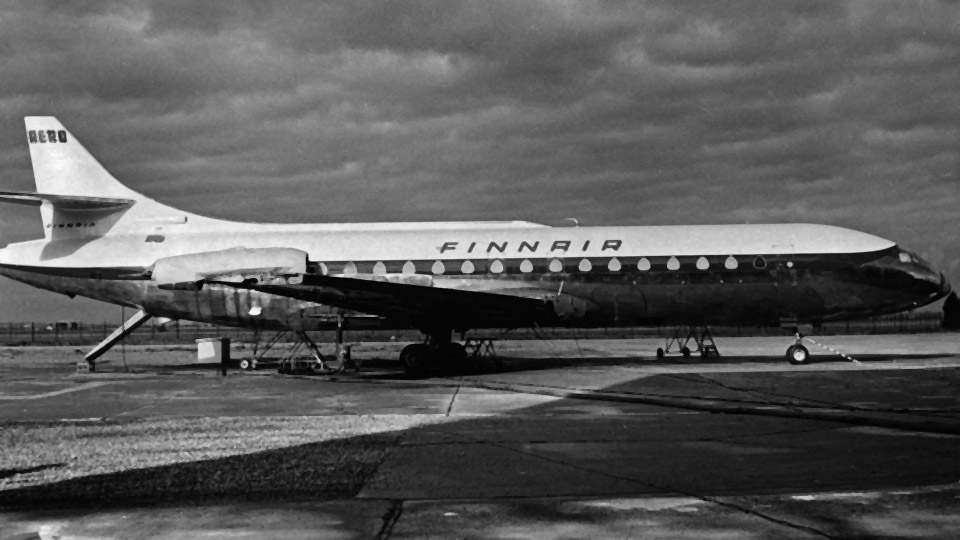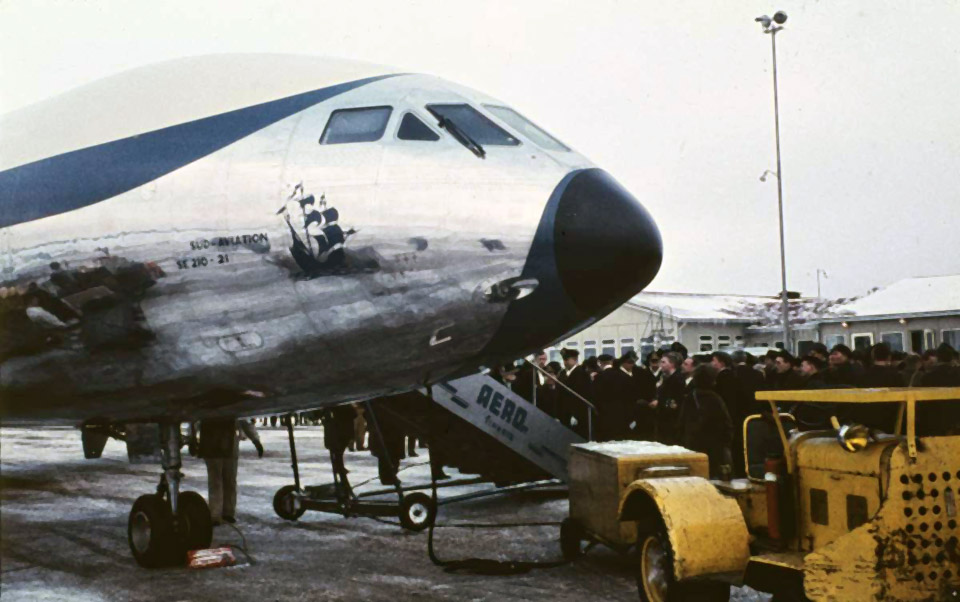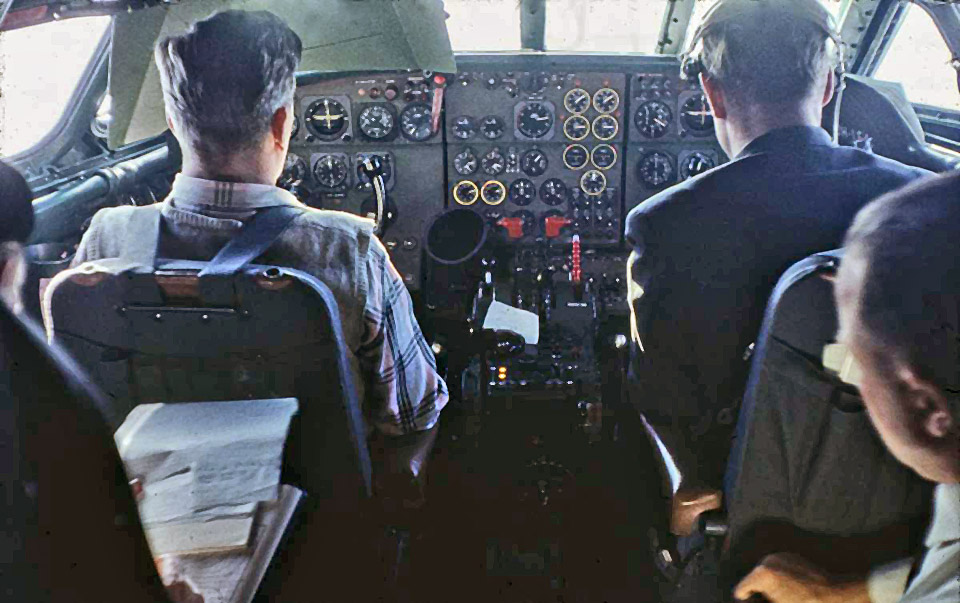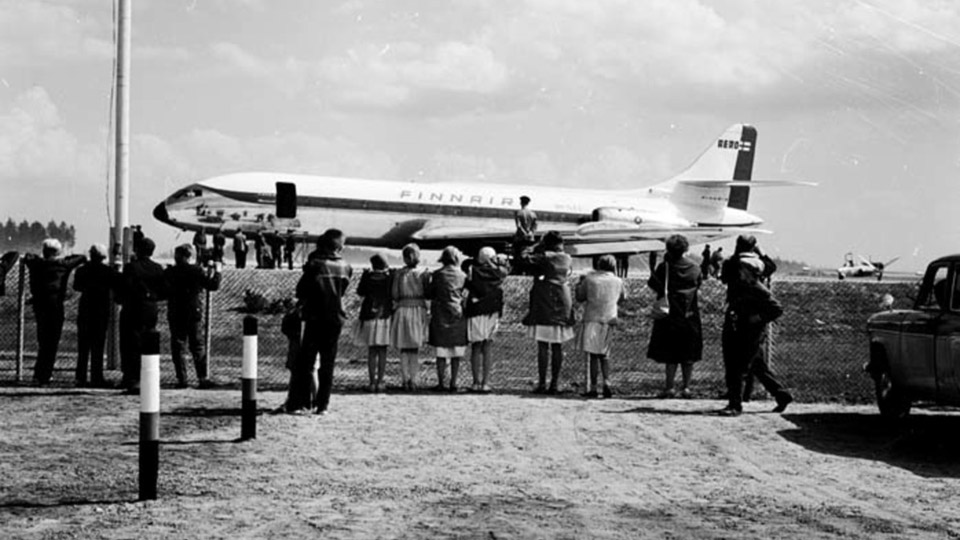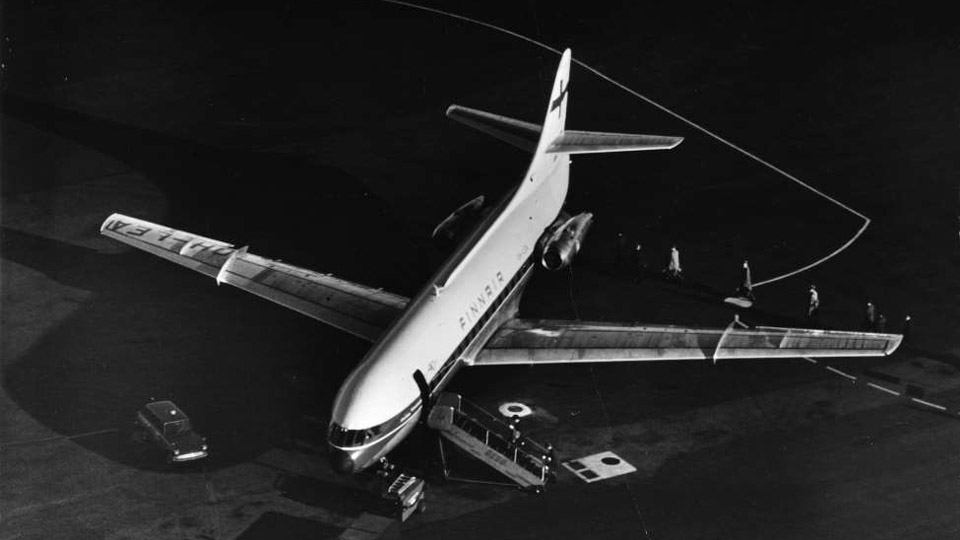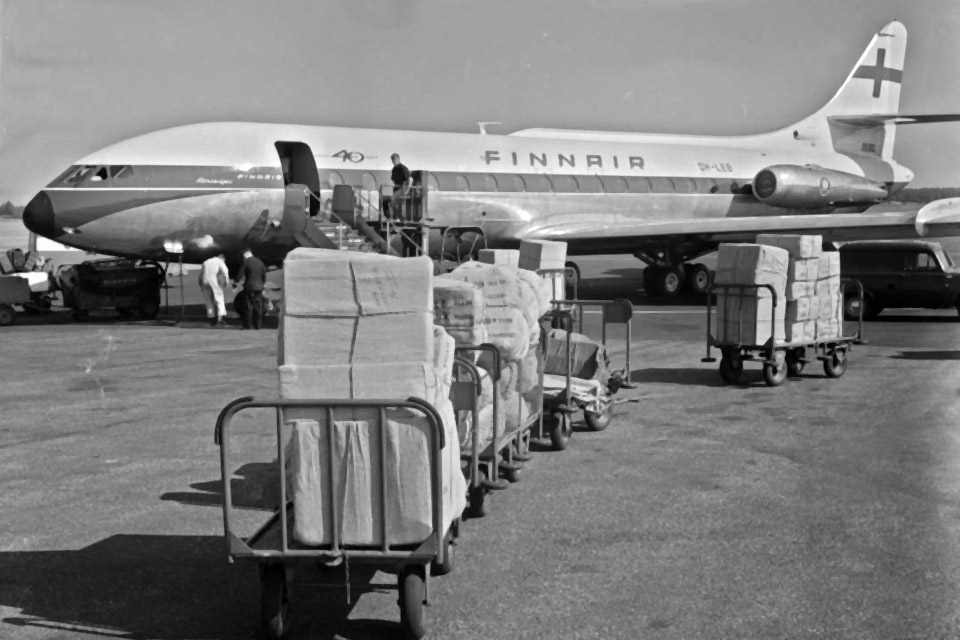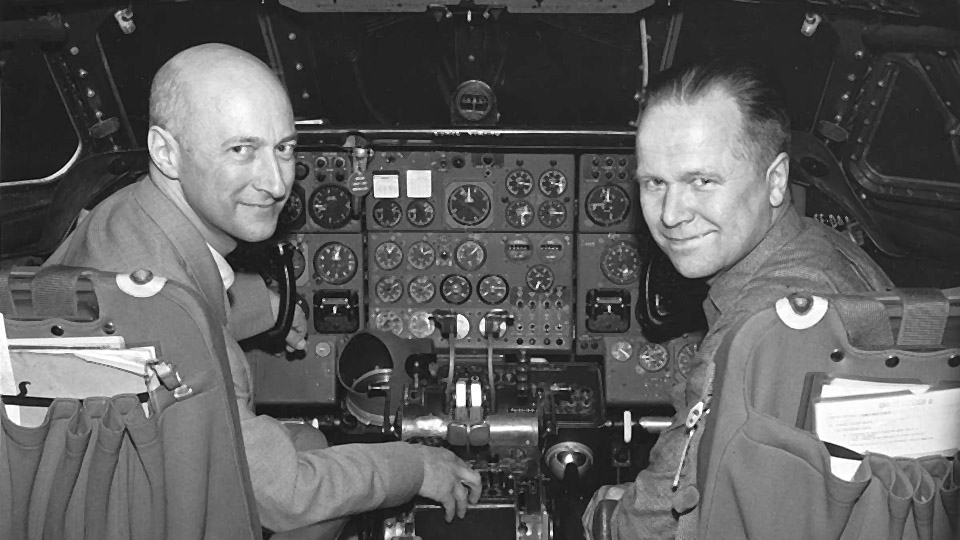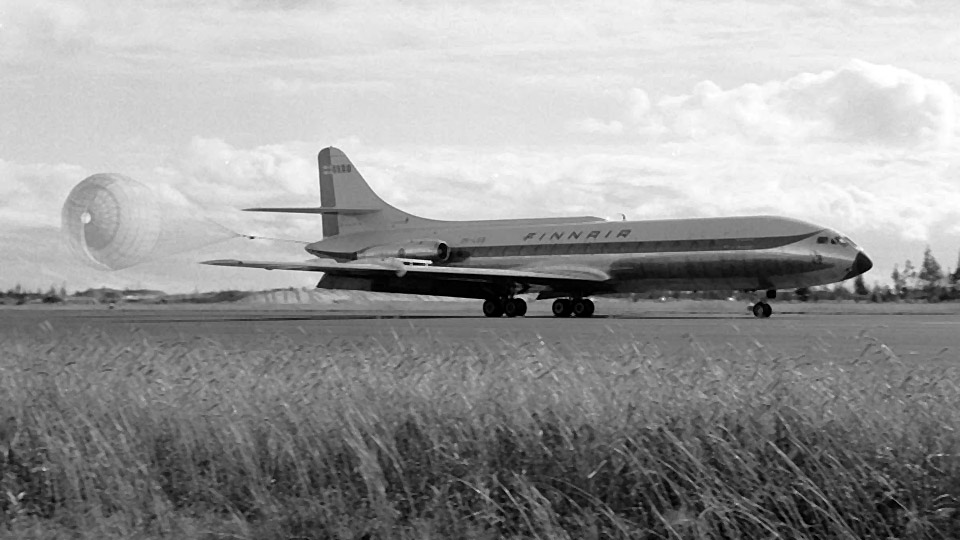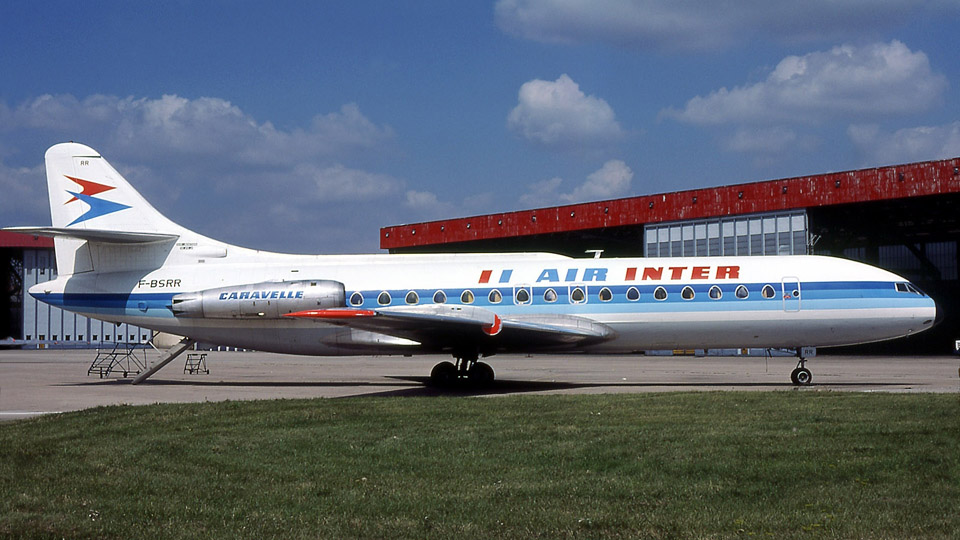Caravelle III OH-LEA "Sinilintu" ("Bluebird")Keskiviikko 29.3.2023 - Erja Reinikainen Suomeksi The Caravelle III, which was brought from Arlanda to Finland by Aviation Museum Society Finland, served in the SAS fleet with registration SE-DAF and name Sven Viking. In Pansio the aircraft is being restored to Finnair colours as its first Caravelle OH-LEA, Sinilintu (Bluebird). This blog tells about the long and colourful history of this aircraft.
Photo by Finnish Aviation Museum photo archive / Ilmailu magazine In 1958 the Finnish airline Aero Oy (later Finnair) ordered three Caravelle IA passenger jets from the French Sud Aviation aircraft factory. The Finnish airline was one of the forerunners of air travel and was the fourth airline to order the new passenger jet type, after Air France, SAS and the Brazilian Varig.
Photo by Finnish Aviation Museum photo archive / Börje Hielm. The first jet aircraft in Finnish civil aviation was Sud Aviation Caravelle IA, which got the registration OH-LEA and was named Sinilintu (Bluebird). It was handed over in Toulouse on February 21st, 1960, and it arrived in Finland on February 22nd, 1960. The aircraft was flown to Finland by Olli Puhakka, who was a former fighter pilot and Knight of the Mannerheim Cross. The co-pilot on the flight was Olavi Siirilä, also a former war pilot. Among the guests of honor on the flight were minister of transport Arvo Korsimo, Aero Oy’s managing director Leonard Grandell, chief editor of the Helsingin Sanomat newspaper Yrjö Niiniluoto and maritime counsellor Antti Wihuri.
Photo by Finnish Aviation Museum photo archive / Börje Hielm. During the spring 1960 the Bluebird was followed by Sinisiipi (Bluewing, OH-LEB) and Sininuoli (Blue Arrow, OH-LEC). These three aircraft were later modified to type Caravelle III. The fourth aircraft was already a Caravelle III when it was purchased in 1962. It was named Sinipiika (Blue Maid, OH-LED).
Photo by Finnish Aviation Museum photo archive / Ilmailu magazine
Photo by Finnish Aviation Museum photo archive / Ilmailu magazine During its service in the Aero fleet the Bluebird appeared in three different paint schemes. It was delivered in its first appearance, where the rudder was blue, and the name Aero was written in large on the upper part of the vertical stabilizer. In the second paint scheme the rudder was blue and a blue cross on the vertical stabilizer replaced the text. Otherwise the paint scheme was identical to the first one. The third painting was done when the aircraft was updated to type Caravelle III. This is the appearance into which the former SAS SE-DAF will now be restored. The paint scheme can be seen in the visualization image on the front page of the Caravelle-project. When Finnair celebrated its 40th anniversary, a special anniversary logo and text were added on the aircraft.
OH-LEB. Photo by Finnish Aviation Museum photo archive / Finnair Oyj In the Finnair fleet the Caravelle had 16 seats in the first class and 75 in the tourist class. Starting from April 1960, the Caravelles operated on routes to European cities. In the beginning the destinations were Stockholm, Copenhagen and Frankfurt, followed by several other cities during the coming years. The Caravelles replaced the Convair 440 Metropolitan piston engine aircraft in Europe, and they were transferred to domestic routes. In late 1961 Oulu was the first domestic route operated with passenger jets.
Olli Puhakka and Olavi Siirilä in the cockpit of Eskil Viking (SAS). Photo by Finnish Aviation Museum photo archive / Ilmailu magazine A Finnish speciality was flying the Caravelles with only two pilots, when other airlines had two pilots and a mechanic in the cockpit. Another remarkable difference was the surrounding and existing environment, which was why the Aero Caravelles had a brake parachute installed. The Caravelle III had Rolls Royce Avon engines and there was no reverse thrust in them to assist in the braking. The brake parachutes were only used when the friction conditions on the runway were really poor. The pilot opened the brake parachute by pulling a handle during the landing run. When the aircraft left the runway, the parachute was released by pulling the same handle. The technical ground crew then collected the parachute for reassembly.
OH-LEB “Sinisiipi” (“Bluewing”) uses drag chute. Photo by Finnish Aviation Museum photo archive / Ilmailu magazine. The OH-LEA Bluebird flew its first flight on February 11th, 1960. It belonged to the Finnair fleet in 1960–61 and logged 9091 hours. The aircraft was sold back to Sud Aviation on December 4th, 1962, and it was flown to France on September 20th, 1964. The following user of the Caravelle was the German LTU, which got the aircraft on February 12th, 1965. It was registered as D-ABAF and named Nordrhein-Westfalen. The next user was Transavia Holland. It rented the aircraft between January 30th, 1969, and April 16th, 1970, as PH-TRM.
F-BSSR in August 1978. Photo by Michel Gilliand via Wikimedia Commons. From the Netherlands the aircraft returned to France, where it was registered as F-BSRR in Air Inter’s fleet where it flew from March 19th, 1971, until December 1980. During this time the Caravelle was rented to Royal Air Maroc and SNIAS, among others, having different registrations. Air Inter sold the aircraft to Altair in Italy, where it was registered I-GISA. It was removed from service in September 1983 with 37 532 hours on its log. But the story doesn’t end here. From Italy the aircraft was bought to Congo by IAC Airlines. In Congo it was registered 9Q-CPS and it was named Santeny. The last airline to use the Caravelle was Air Transport Service, which flew it until 1994. The Caravelle was scrapped in 1996 at the N’djili international airport in Kinshasa, Congo. As we can see, OH-LEA was an individual with a long history. It served for 36 years, and it had more user airlines and operators than any other first generation Caravelle. Following sources have been used for this blog:
|
|
Avainsanat: aviation history, restoration, Caravelle, SE-DAF, Sven Viking, OH-LEA, Sinilintu, Bluebird |


